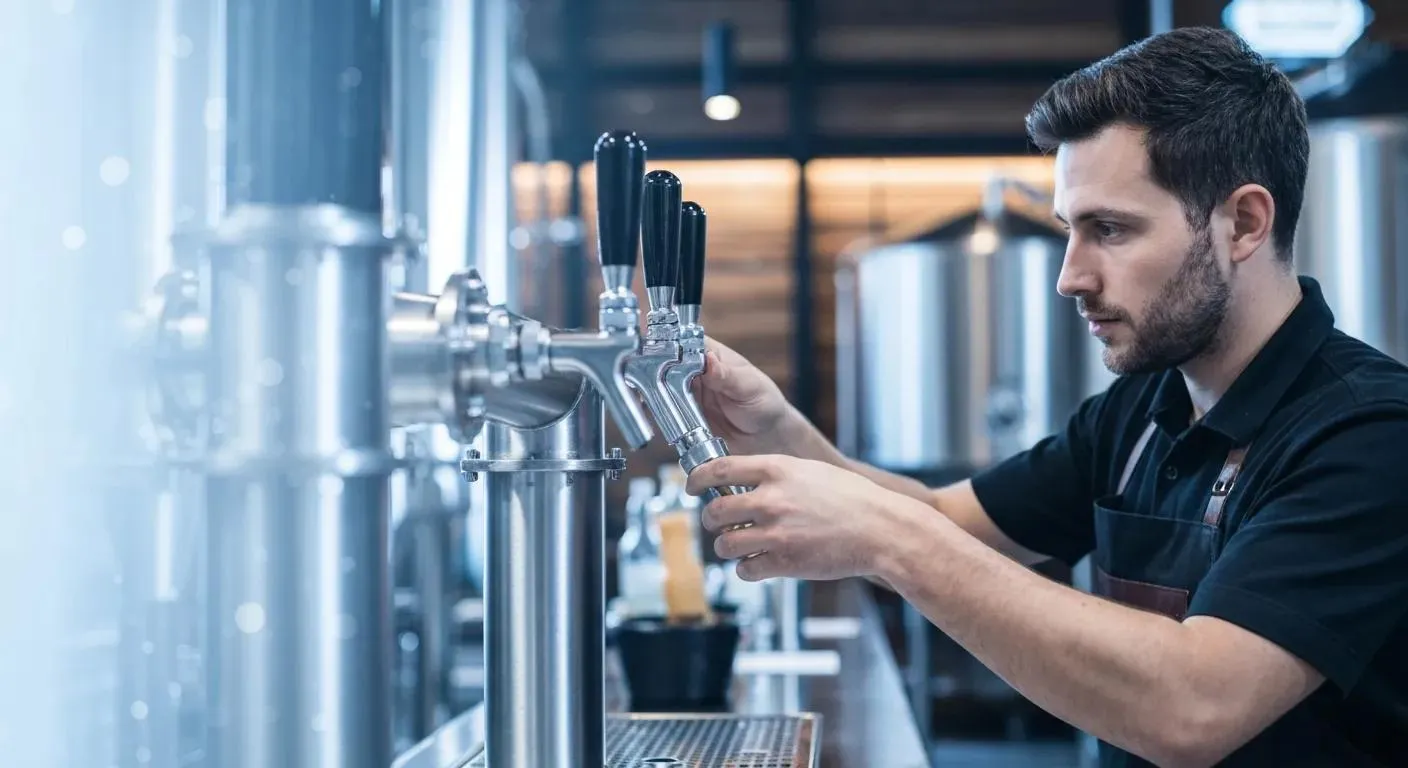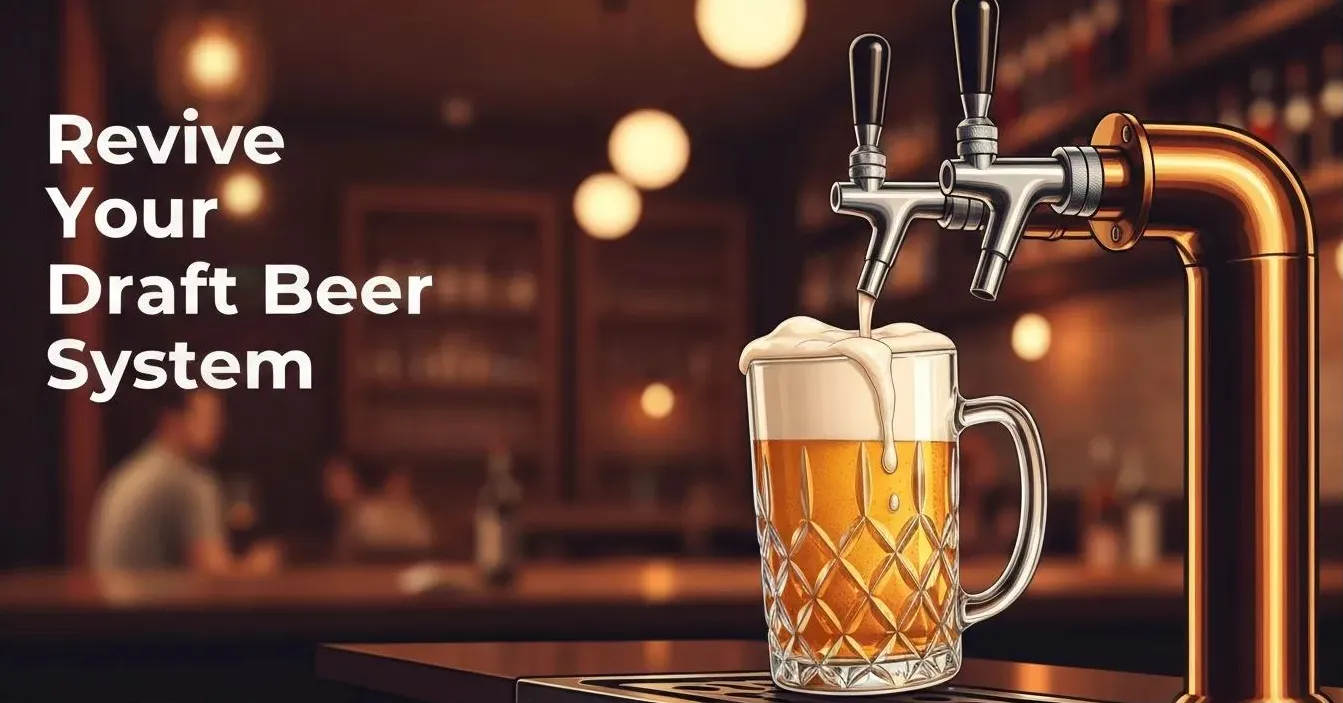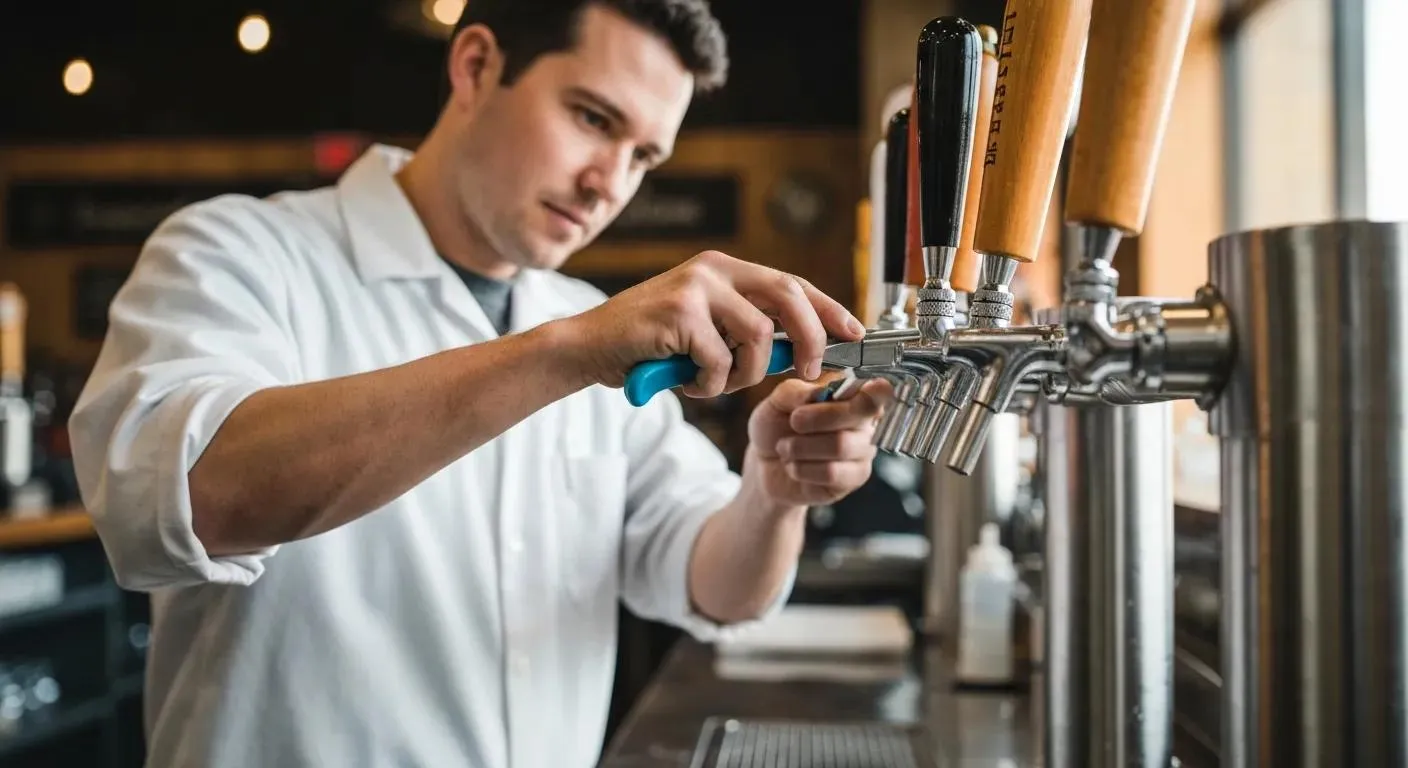Bar Beer Tap Essentials: Choosing the Best System for Your Establishment

In the world of home and commercial bars, the bar beer tap is a quintessential component that serves as the final passageway between keg and glass, allowing beer enthusiasts to enjoy their favorite brews on tap.
The allure of a perfectly poured pint, with its effervescent bubbles and creamy head, starts with a well-designed beer tap system that can be the centerpiece of any bar setting.
The choice of a beer tap goes beyond aesthetics and price, playing a crucial role in the quality and taste of the beer dispensed, making the understanding and selection of the right equipment essential.
Installing a bar beer tap system requires thoughtful planning and attention to detail.

The process includes selecting the various materials, appropriate kegs, couplers, and related hardware to ensure seamless operation.
It’s important to consider the space where the beer tap will be situated and the type of system.
You can choose a simple direct draw setup for smaller applications or a more complex long draw system for more customers and larger establishments.
Moreover, regular maintenance and cleaning are vital to keep the beer flowing smoothly and maintain its intended flavor.
Key Takeaways
- A bar beer tap system is key for serving quality draft beer.
- Proper installation and choice of equipment are essential for optimal function.
- Regular maintenance ensures sustained beer quality and dispensing.
Understanding Beer Tap Systems
In exploring beer tap systems, one should focus on the mechanisms that facilitate the dispensing of beer and the various configurations available for different settings.
Components of a Beer Tap System
Faucet: The faucet is the point of dispense, where beer is poured into a glass. It is typically connected to a tap handle, which controls the flow of beer. Recommend you use only stainless steel faucets.
Beer Tower: A beer tower is mounted on the bar top and houses the faucets. It is a visual feature of the system and can often accommodate multiple faucets.

Keg Coupler: The keg coupler connects to the keg valve, "tapping" the keg. It is a critical component that allows CO2 to enter the keg and pushes beer out. Again, stainless couplers should be used only.
Regulator: The regulator controls the pressure of the CO2 gas being delivered from the tank to the keg. Proper pressure ensures the beer maintains the right level of carbonation.

CO2 Tank: CO2 is essential in a draft beer system to preserve the beer and drive it from the keg through the lines to the faucet.
Types of Beer Tap Systems
Direct Draw System: Ideal for small-scale operations, a direct draw system usually involves a kegerator where the keg is stored in a refrigerated cabinet directly beneath the tap.
Remote Beer System: Typically a type of long draw system, remote beer systems can dispense beer over long distances, employing glycol-cooled lines to maintain the beer's temperature from keg to faucet.

Installation and Setup
When installing a bar beer tap, selecting an appropriate location is essential for both functionality and ease of use.
The setup must be meticulously planned to incorporate all necessary components such as beer lines, glycol lines for temperature control, and insulation to maintain beer quality.
Selecting the Right Location
The location of your beer tap is a critical first step in the installation process.
It should offer enough space for the draft system and be conveniently accessible for both the staff and maintenance.
When choosing the location, one must consider the proximity to a power supply for glycol systems and the length of the beer lines to minimize the risk of temperature fluctuations that can affect the beer's taste.
- Criteria for Location Selection:
- Ample space for equipment and movement
- Accessibility for staff and servicing
- Close proximity to a power source
- Short beer line runs for optimal temperature control
Installing a Draft Beer System
The installation of a draft beer system includes setting up the draft tower, connecting beer, glycol, and air lines, and ensuring proper insulation. Follow these steps for a standard installation:
1. Mounting the Beer Tower
- Location Selection: Choose a location for your beer tower that is easily accessible and allows for proper drainage.
- Drilling the Countertop: Drill a hole in your countertop where the tower will be mounted. Ensure the hole is the correct size for your tower's base.
- Securing the Tower: Place the tower over the hole and use mounting hardware to secure it to the countertop. Make sure it is stable and upright.
2. Running the Beer Lines
- Measure Distance: Measure the distance from the keg to the beer tower. This helps determine how much beer line you will need.
- Insulating Beer Lines: Use insulated beer lines to maintain the beer’s temperature from the cooler to the tap. The lines should also be bundled with the glycol lines to prevent freezing.

- Running Lines: Run the lines through the drilled hole in the countertop, extending them to the location of the kegs.
3. Installing the Glycol System
- Setting Up the Glycol Chiller: Place the glycol chiller near the kegs, usually in the same room or a nearby location to minimize distance.
- Connecting Glycol Lines: Connect the glycol lines to the chiller and run them alongside the beer lines to the tower. The glycol lines help maintain the optimal temperature of the beer lines.
4. Setting Up the Kegs
- Keg Placement: Place the kegs in a cooler or refrigerated environment to keep the beer at the right temperature.
- Connecting to Couplers: Attach the appropriate couplers to the kegs. Ensure they are tightly sealed to prevent leaks.
5. Connecting the Lines
- Beer Lines to Couplers: Attach the beer lines from the tower to the kegs using the couplers. Make sure all connections are secure and free of leaks.
- Glycol Lines to Beer Lines: Attach the glycol lines around the beer lines using clamps to ensure they are in close contact to maintain temperature.
6. Balancing the System
- Pressure Adjustments: Adjust the CO2 pressure according to the type of beer and the length of the beer lines. Typically, the pressure should be between 12-14 PSI for ales and lagers.
- Testing Flow Rate: Test the flow rate from the taps. A well-balanced system should pour a pint in about 8-10 seconds. Adjust the pressure if the beer pours too quickly or too slowly.
7. Final Testing and Adjustments
- Check for Leaks: Inspect all connections for leaks. Use soapy water to identify any gas leaks.
- Pour a Test Pint: Pour a few test pints to check the quality of the beer. Look for appropriate temperature, carbonation, and absence of foam issues.
8. Maintenance
- Regular Cleaning: Clean the lines, taps, and couplers regularly to maintain the quality and flavor of the beer.
- System Check-Ups: Periodically check the glycol system and CO2 pressures to ensure everything is functioning properly.
Following these steps will help you set up a remote draft beer system that is balanced correctly and capable of pouring the perfect pint. Regular maintenance is crucial to keep the system operating efficiently and the beer tasting great.
Beer Kegs and Couplers
When considering a draft beer system, one must understand the intricacies of beer kegs and the couplers that allow for the perfect draft pour. Each type of beer keg requires a specific coupler to ensure an airtight connection between the keg and the beer line.
Keg Types and Sizes
Beer kegs come in various sizes and styles which suit different needs and draft systems. The most common types are:
- Half Barrel: Also known as a full-size keg, typically holds 15.5 gallons of beer, equivalent to about 165 12-oz servings.
- Quarter Barrel: Often called a pony keg, holds 7.75 gallons, or roughly 82 12-oz servings.
- Sixth Barrel: Also referred to as a torpedo keg, contains 5.16 gallons, amounting to approximately 55 12-oz servings.
- Cornelius Keg: Popular among homebrewers, this keg capacity is usually 5 gallons.
To use these kegs, a matching kegerator is essential to cool and dispense the beer effectively.
Couplers and Connections
A keg coupler acts as the key to tapping a keg and is crucial for a functioning draft beer system. The primary types of keg couplers include:
- A-system: Predominantly for German beers
- D-system: Common for most North American beers
- S-system: Often used for European beers
- M-system: Less common, compatible with certain European brands
- G-system: Applicable for some English beers
Each keg coupler attaches to its respective keg valve, forming a secure seal that allows CO2 gas to enter and push the beer out. The keg coupler's probe mechanism varies according to the keg's design, ensuring that the correct coupler is used for the corresponding keg type. For a thorough look at the range of couplers available, consult an extensive list of keg couplers for guidance.
Maintenance and Cleaning
Proper maintenance and cleaning are essential for ensuring the taste and quality of beer served from taps. This requires regular sanitization to prevent bacteria buildup and thorough upkeep of all tap system components.
Regular Cleaning Schedule
For optimal beer quality, cleaning the beer lines, faucets, beer faucet, beer shank, tap tower, and drip tray should be conducted at regular intervals. It’s recommended to clean these components at least every two weeks.
Cleaning involves running a suitable cleaning solution through the beer lines to remove any residue and kill bacteria that can affect beer flavor and safety. After cleaning, rinsing with clean water is critical to remove all traces of the cleaning agent.
Maintaining Components
Maintenance of a beer tap system includes regularly checking and replacing any worn parts. This helps avoid costly repairs or replacements in the future.
- Faucets: Should be disassembled and cleaned individually to prevent beer stone accumulation and bacterial growth.
- Beer Shank: This connects the faucet to the beer line and should be inspected for any signs of damage or corrosion.
- Tap Tower: Ensure insulation is intact to maintain the correct beer temperature and prevent foaming.
- Drip Tray: Regular emptying and cleaning are crucial to maintaining hygiene and preventing odors.
Enhancing Beer Quality and Dispensing
In the pursuit of delivering high-quality draft beer, two core factors dominate the process: the regulation of carbonation and the technicalities that ensure every glass of beer is served with the right texture and taste.
Optimizing Carbonation and Flavor
Carbonation is pivotal in determining the texture and flavor of beer. Proper CO2 levels ensure that beer retains its fizz and tang, which is crucial for a refreshing experience. Meanwhile, introducing nitrogen into the mix can lead to a creamier mouthfeel and is often employed in stouts to achieve a smoother pour.
- CO2 Levels: Typically, a range of 2.4 to 2.8 volumes of CO2 is ideal for most beers.
- Nitrogen Mixes: Commonly at a ratio of 70% nitrogen to 30% CO2 for a creamier, less bubbly head.
Ensuring the Perfect Pour
To achieve the perfect pour, several elements need to be finely tuned. Flow control devices enable bartenders to adjust the serving speed of beer, directly affecting the beer's presentation and foam head. Additionally, the use of creamers or specialized faucets can enhance the texture of the beer's head, delivering a consistent quality with each serving.
- Flow Control: Adjust as needed for the desired speed and head formation.
- Creamer Faucets: Used to produce a dense, creamy head, especially in nitrogenated beers.
Summary
When selecting a beer tap system for a home or commercial bar, one must consider various types and styles to ensure the system meets their specific needs.
Standard and European beer faucets are among the common styles.
The choice between rear-sealing and forward-sealing faucets affects maintenance and the quality of the draft beer served.
For home bars or mobile gatherings, options like a portable jockey box provide convenience and mobility.
In contrast, establishments such as restaurants or busy bars might opt for either manual or self-serve beer taps, each catering to different customer experiences.
Commercial spaces often invest in long draw systems where the kegs are stored away from the taps. These systems require effective cooling methods such as glycol lines to keep the beer at an optimal temperature during its journey from keg to faucet.
The most commonly found system in bars is the direct draw system, where kegs are housed within a cooler, positioned in close proximity to the taps. This setup is popular for its versatility and the array of benefits it offers.
In summary, the key considerations for choosing a beer tap system include:
- Type of faucet: Standard, European, rear-sealing, or forward-sealing
- Location and space: Home, event, or commercial
- System type: systems such as direct draw or long draw
- Customer experience: Manual pour versus self-service



